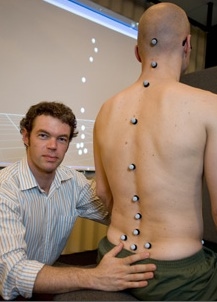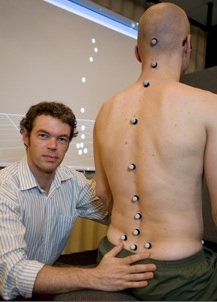By Dr Andrew Claus (the handsome fellow in the stripy shirt)
Sitting cops a lot of bad press, but the science to compare postures is pretty weak. One of our studies undertaken at the University of Queensland examined whether people could copy four sitting postures. Most people couldn’t sit with a curve-in at the low back (like standing, as thought to be ‘good’ sitting posture) unless they were taught how to do it. Perhaps people need to be taught how to adjust their back posture as well as their chair, or perhaps it is unrealistic to expect people to sit like this. More research is needed, but in the meantime – sit comfortably, and have a read of the ABC’s article on our research ‘Ideal’ sitting posture questioned.
Is ‘ideal’ sitting posture real?: Measurement of spinal curves in four sitting postures
Andrew P. Claus(a), Julie A. Hides(a), G. Lorimer Moseley(b), Paul W. Hodges(a)
(a) NHMRC Centre of Clinical Research Excellence in Spinal Pain, Injury and Health, School of Health and Rehabilitation Sciences, The University of Queensland, Brisbane, St. Lucia, QLD 4072, Australia
(b) Department of Physiology, Anatomy and Genetics, University of Oxford, Oxford, UK
There is a lack of quantitative evidence for spinal postures that are advocated as ‘ideal’ in clinical ergonomics for sitting. This study quantified surface spinal curves and examined whether subjects could imitate clinically ‘ideal’ directions of spinal curve at thoraco-lumbar and lumbar regions: (i) flat – at both regions (ii) long lordosis – lordotic at both regions (iii) short lordosis – thoracic kyphosis and lumbar lordosis. Ten healthy male subjects had 3-D motion sensors adhered to the skin so that sagittal spinal curves were represented by angles at thoracic (lines between T1–T5 and T5–T10), thoraco-lumbar (T5–T10 and T10–L3) and lumbar regions (T10–L3 and L3–S2). Subjects attempted to imitate pictures of spinal curves for the flat, long lordosis, short lordosis and a slumped posture, and were then given feedback/manual facilitation to achieve the postures. Repeated measures analysis of variance was used to compare spinal angles between posture and facilitation conditions. Results show that although subjects imitated postures with the same curve direction at thoraco-lumbar and lumbar regions (slumped, flat or long lordosis), they required feedback/manual facilitation to differentiate the regional curves for the short lordosis posture. Further study is needed to determine whether the clinically proposed ‘ideal’ postures provide clinical advantages.
See full article at Manual Therapy 14,4, 404-8




